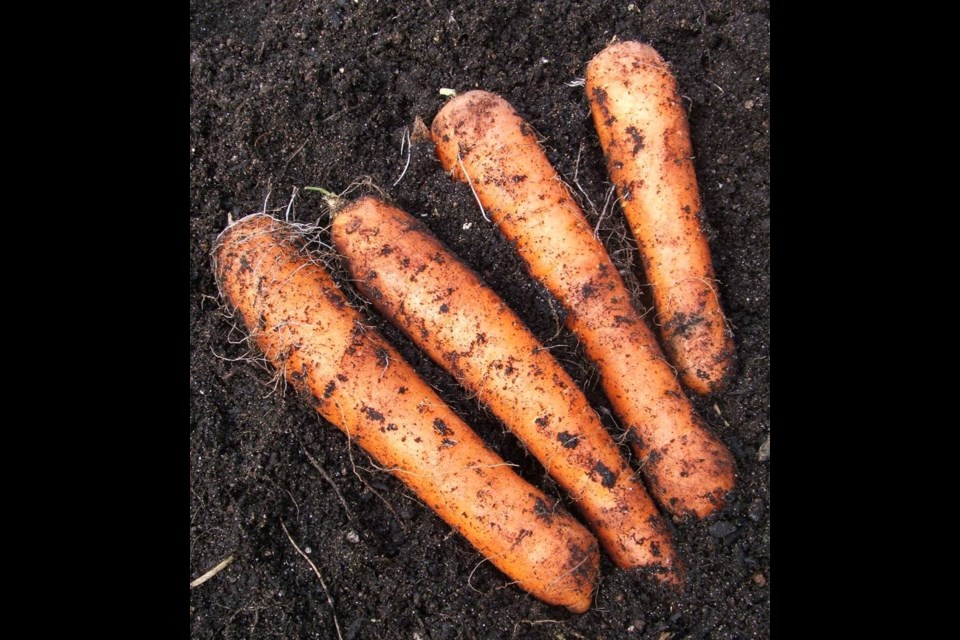Working and speaking with new gardeners on my street has been instructive. The latest, surprising revelation began when Karen and Tanya asked for a tour through the garden. After observing the vegetable plantings, the berry bushes, and fruiting trees and vines, they commented that I must have a super-sized freezer.
I do not. My freezer is a modest size. But I didn’t think any more about the comment until a next-door neighbour stopped me on my way to the nearby mail boxes to tell me how she was busily blanching and freezing beets and other vegetables in her newly established food garden.
As she spoke I realized that she, and probably the neighbours who made the freezer comment, did not know that many edibles can be stored right where they’ve grown, out in the garden.
Of course, many must be harvested at their peak and used, or processed and stored — the berries, tree fruits, tomatoes, cucumbers, peppers and so on. But cold-hardy foods can be left in the garden, with simple measures in place to protect them from severe temperatures.
Root vegetables store in fine eating condition in the soil where they grew. My bed of carrots, parsnips and beets feeds me through the winter and into early spring. A five-cm cover of soil over the roots once the tops have withered and are cleared away protects the root “shoulders” from frost damage. In some winters, when severe freezing temperatures are expected, I spread sheets of old floating row cover over the plantings too.
Another, smaller bed containing a second carrot planting and two varieties of daikon radish, all seeded at the beginning of July, will get the same treatment. Last winter, my friends and I enjoyed a daikon called Alpine, from Johnny’s Selected Seeds (JSS), grated into green salads and combined with grated carrot and sometimes apple in a lemon juice and oil vinaigrette.
This year, I have a planting of Alpine again, joined by another from JSS. KN-Bravo has grown even more vigorously than Alpine. This autumn I’m looking forward to savouring the purple and white flesh of this daikon.
Almost all leek varieties are fine left in the garden and can be harvested through the winter. Kale fares well through most winters, as do many hardy green leafy vegetables. They include cold-hardy lettuces, whose names sometimes indicate their tolerance of cold temperatures. Examples are Winter Density and Arctic King.
Many flavourful leafy green vegetables that add zest to winter salads also can weather the cold. My favourites: endive, spinach, mizuna, radicchio and komatsuna.
A mulching around the plants late in the fall helps to protect their roots. If severe freezing temperatures are about to visit the garden, cover the greens temporarily with old floating row cover, lightweight curtaining, or whatever you have on hand. One winter, I saved a prized bed of radicchio with three layers of row cover.
Winter vegetable enthusiasts delight in growing overwintering cauliflower and sprouting broccoli for the fresh, tasty foods they provide in late winter and early spring.
Transplants of many cold-hardy vegetables are available in garden centres this month, for anyone interested in transforming part of the garden into an outdoor winter pantry.
Of cats and squirrels. The cats-and-birds saga continues as notes keep rolling in on the predatory nature of free-roaming cats and on measures taken to reduce the success rate of their hunting, such as jingly bells and colourful, clown-like ruffs around the neck.
The latest lament, from a reader in Saanich, describes the disappearance of quail, lizards and snakes in her garden and in the wider neighbourhood with the arrival of families with “outdoor” cats.
The reader has a suggestion. Allow cats to enjoy the outdoors in safety and protect wildlife at the same time by installing a “catio.”
What’s a catio? A patio for cats — an outdoor enclosure that can be a cat run, a cat playpen, a windowbox or balcony space, or some other variation. See the possibilities at catioworld.com.
Wendy, who gardens in Brentwood Bay, sent in a smile-inducing photo of a squirrel stretching to reach the rim of a trug.
“It was such a ‘chance’ picture. I was sitting inside and my puppy did not spot and chase away the squirrel.” Wendy’s caption for the photo: “My helper.”



